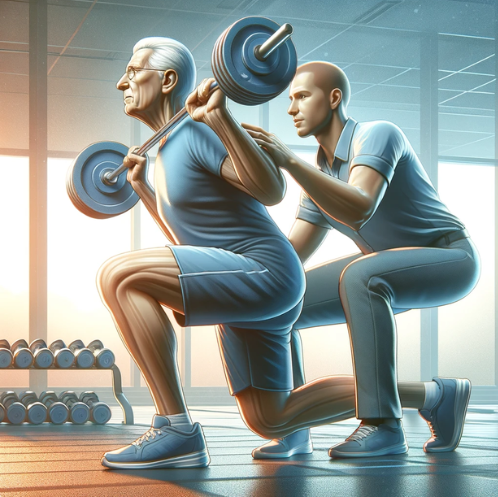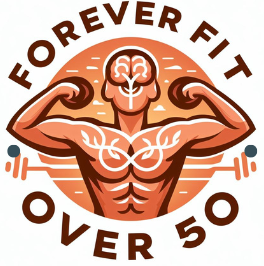Unveiling the Foundations: Why Begin with Strength Training?

Strength training is not just a path to physical prowess; it’s a cornerstone of a balanced fitness regimen, especially for those over 50. Like a gardener nurturing a plant from the seed, strength training helps your body grow stronger and more resilient. It stands distinct from cardio and flexibility exercises, acting as the bedrock upon which your physical health can flourish. For those over 50, it’s the keystone in the arch of fitness, supporting and enhancing all other forms of exercise you engage in.
Creating Your Strength Training Regimen: Key Principles for Over 50

Embarking on a strength training journey later in life offers a myriad of health benefits, including improved muscle mass, better bone density, enhanced flexibility, and a reduced risk of chronic diseases. However, individuals over 50 must approach strength training with careful consideration to maximize benefits while minimizing the risk of injury. Below are expanded key principles to guide those over 50 in developing a safe and effective strength training regimen.
Start Slow and Emphasize Form
Begin with light weights or bodyweight exercises to allow your body to adapt to new movements. Proper form is crucial to prevent injuries and ensure the effectiveness of each exercise. Consider working with a certified personal trainer who has experience training older adults. They can provide personalized feedback on your form and recommend modifications to suit your fitness level and any physical limitations.
Incorporate Rest and Recovery
Recovery is as important as the workout itself, especially as we age. Our bodies take longer to heal and recover from strenuous activity, making rest days essential. Include at least 48 hours of rest between sessions targeting the same muscle groups to allow for muscle repair and growth. Additionally, focus on quality sleep, as it plays a critical role in recovery, muscle growth, and overall health.
Frequency Recommendations
For beginners over 50, aim for two to three strength training sessions per week. This frequency is sufficient to see improvements in strength and muscle tone without overtaxing the body. As you progress and become more comfortable with the exercises, you can gradually increase the frequency, ensuring you maintain at least one full rest day between sessions to allow for recovery.
Balance and Variety
A well-rounded strength training program should target all the major muscle groups, including the legs, hips, back, abdomen, chest, shoulders, and arms. Incorporating a variety of exercises helps prevent boredom, improves overall body strength, and reduces the risk of overuse injuries. Exercises like squats, deadlifts, push-ups, bench presses, and planks offer a comprehensive workout that engages multiple muscle groups simultaneously. Additionally, include exercises that focus on balance and flexibility, such as yoga or Tai Chi, to complement your strength training regimen.
Progression and Adaptation
As your strength improves, gradually increase the intensity of your workouts to continue challenging your muscles. This can be achieved by adding more weight, increasing the number of repetitions or sets, or incorporating more complex exercises. However, always prioritize form over the amount of weight lifted to avoid injury. Listen to your body and adjust your training plan accordingly. If you experience pain or discomfort, scale back and consult with a healthcare provider or fitness professional.
Mind the Mind-Muscle Connection
Focus on the muscles you’re working during each exercise. This mind-muscle connection improves exercise efficacy and can enhance strength gains. It also helps in maintaining proper form and preventing injuries.
Safety First
Always warm up before and cool down after your strength training sessions. A proper warm-up increases blood flow to the muscles and prepares your body for the workout, reducing the risk of injury. Cooling down helps to gradually lower your heart rate and can reduce post-exercise soreness.
By adhering to these principles, individuals over 50 can safely enjoy the benefits of strength training. Remember, the journey to fitness is a marathon, not a sprint. Celebrate your progress, no matter how small, and enjoy the improved quality of life that comes with being stronger and healthier.
Top 5 Strength Training Exercises for Over 50

- Squats: The cornerstone of lower body strength, squats are like the roots of a tree, foundational and spreading wide to support growth. They can be modified to suit any level, ensuring everyone can embrace their benefits.
- Deadlifts: Embodying the essence of lifting something off the ground, deadlifts teach you the art of bending and extending, akin to the rise and fall of the sun, emphasizing the cyclical nature of strength.
- Push-ups: Building upper body strength, push-ups are the push against the earth that propels a bird into flight. They can be adapted for various fitness levels, allowing everyone to soar at their own pace.
- Bench Press: Introducing the uninitiated to the world of free weights, the bench press is akin to setting sail on a calm sea, guiding you into the vast ocean of strength training with the safety of form and technique.
- Plank: For core development, the plank acts as the central pillar of a bridge, connecting and strengthening the entire body with variations that invite all to cross at their own speed.
Supporting Your Journey: Nutrition and Hydration Essentials

As a sculptor needs clay, your body needs proper nutrition and hydration to mold and strengthen. Think of protein as the bricks for muscle building and repair, while hydration acts like the mortar, essential for binding strength and facilitating recovery. Incorporate a rainbow of fruits, vegetables, and lean proteins into your diet to paint your canvas of health. Supplements, like the flourish of a painter’s brush, should only complement, not replace, the rich tapestry of nutrients from real food.
Here are some Recipe Ideas to check out: Heart Healthy Recipes for Seniors & Weekly Diet Plan To Boost Energy
Measuring Progress and Adjusting Your Path: A Guide for Over 50

Setting realistic goals is like charting a map for a voyage; knowing where you’re headed is essential. Track your workouts as a captain logs their journey, noting the currents of progress. Progress is more than a number on a scale—it’s the strength to carry groceries effortlessly or the energy to play with grandchildren. As you grow stronger, like a river shaping the landscape, adjust the intensity of your workouts to carve deeper into your potential.
Embarking on strength training over 50 is not just about building muscle; it’s a journey of transformation, resilience, and discovery. With the right exercises, nutritional support, and a community to guide you, the path to a stronger, healthier you is well within reach.
Here’s a little transparency: Our website contains affiliate links. This means if you click and make a purchase, we may receive a small commission. Don’t worry, there’s no extra cost to you. It’s a simple way you can support our mission to bring you quality content.


I found this post so inspiring. It is a balanced holistic view that makes sense. It sparked my interest with a few insights I had not thought of. Community support. Making us feel like we are not alone in this and why strength matters. Also the amount of workouts necessary to gain the strength gradually. Do you recommend anything different for women?
Hello Vivien,
Thank you so much for your wonderful feedback! I’m thrilled to hear that the article inspired you and introduced new perspectives, especially on the importance of community support and the tailored approach to gaining strength. It’s heartening to know that the holistic view presented resonated with you.
When it comes to strength training for women over 50, the principles largely remain the same, with an emphasis on safety, gradual progression, and balance. However, considering women’s unique health considerations, especially post-menopause, it might be beneficial to focus on exercises that target bone density and support hormonal balance. Weight-bearing exercises and resistance training can be particularly effective for maintaining bone health. Incorporating Pilates or yoga can also offer strength-building benefits while enhancing flexibility and core stability, which is crucial for overall well-being. When it comes to Strength Training for either women or men as they enter the golden years, should be done first by consulting with your doctor and second with a trainer that can develop the “Right” program and/ or diet specifically for you. If interested please check out our Blog for further information.
Nutrition plays a key role in supporting your strength training journey, with a focus on calcium, vitamin D, and protein to aid in bone health and muscle repair. It’s also important to stay hydrated and ensure your body gets the rest it needs to recover.
Remember, listening to your body is paramount. Adjusting exercises to suit your comfort level and seeking professional advice when necessary can help you maintain a consistent and enjoyable strength training routine.
Thank you for emphasizing the value of community in this journey. Knowing we’re not alone in our fitness endeavors can make all the difference. If you have any more questions or need further advice, please don’t hesitate to reach out. Here’s to a strong, empowered, and healthy life!
Warmest regards,
Gary
I’ve recently crossed the 50-year threshold and am keen on maintaining my physical health. Strength training seems crucial, but I’m unsure where to start, particularly to avoid injury. Could you recommend exercises that are both effective and safe for someone with little experience in this area? I’m especially interested in those that could be done at home with minimal equipment. Thank you!
Hi Corey,
Starting strength training over 50 is a commendable decision, and since you had mentioned using resistance bands in another article you commented on I thought I’d focus on incorporating resistance bands as a fantastic way to enhance safety and effectiveness. Here are five foundational exercises identified in What Are the Best Strength Training Exercises for Over 50, tailored for your needs:
Squats: Resistance bands can add extra resistance to squats, increasing muscle engagement. Place the band under your feet and hold the ends with your hands, maintaining tension as you stand up from your squat.Deadlifts: Similar to squats, stand on the band and hold the ends while you hinge at the hips to simulate the deadlift movement. This targets the lower back, glutes, and hamstrings with reduced risk.Push-ups: Loop a band across your back and under your hands to add resistance to push-ups, enhancing upper body strength without the need for weights.Bench Press: While lying on your back, press upwards against the resistance band, mimicking the bench press. You can do this on the floor or a bench, targeting the chest, shoulders, and triceps.Plank: For an added challenge to your core, place the band around your back and in your hands while in a plank position to increase tension.
Incorporating these exercises into your routine can significantly improve strength and stability, offering a solid foundation for physical health past 50. Always focus on proper form and start with lighter resistance to build up safely. After a couple of months with the above, should you need additional exercises, feel free to reach out. Happy training!
Regards,
Gary
Hey great post you have here!
This is a good post to share as well since I know many individuals who are touching that age, think that strength training isn’t suitable for that age range however you here have surely debunked that myth which I appreciate!
Like you have stated warming up is essential as well as starting slow!
Thanks again and have a great day!
Hi Sariya,
Thank you so much for your positive feedback on the article, “What are the Best Strength Training Exercises for Over 50.” I’m thrilled to hear that you found the post valuable and that it helped debunk the myth that strength training isn’t suitable for those of us entering this vibrant stage of life.
It’s essential to spread the word that, with the right approach and precautions like warming up and starting slow, strength training can be a beneficial and integral part of maintaining health and vitality after 50. I’m grateful you’re sharing this message with others who might still hold reservations about embracing these exercises.
Your encouragement and recognition means a great deal to me. Let’s continue to support and inspire each other on this journey to stay strong and healthy. Have a fantastic day, and thank you once again for your kind words and for being part of our community!
Warm regards,
Gary